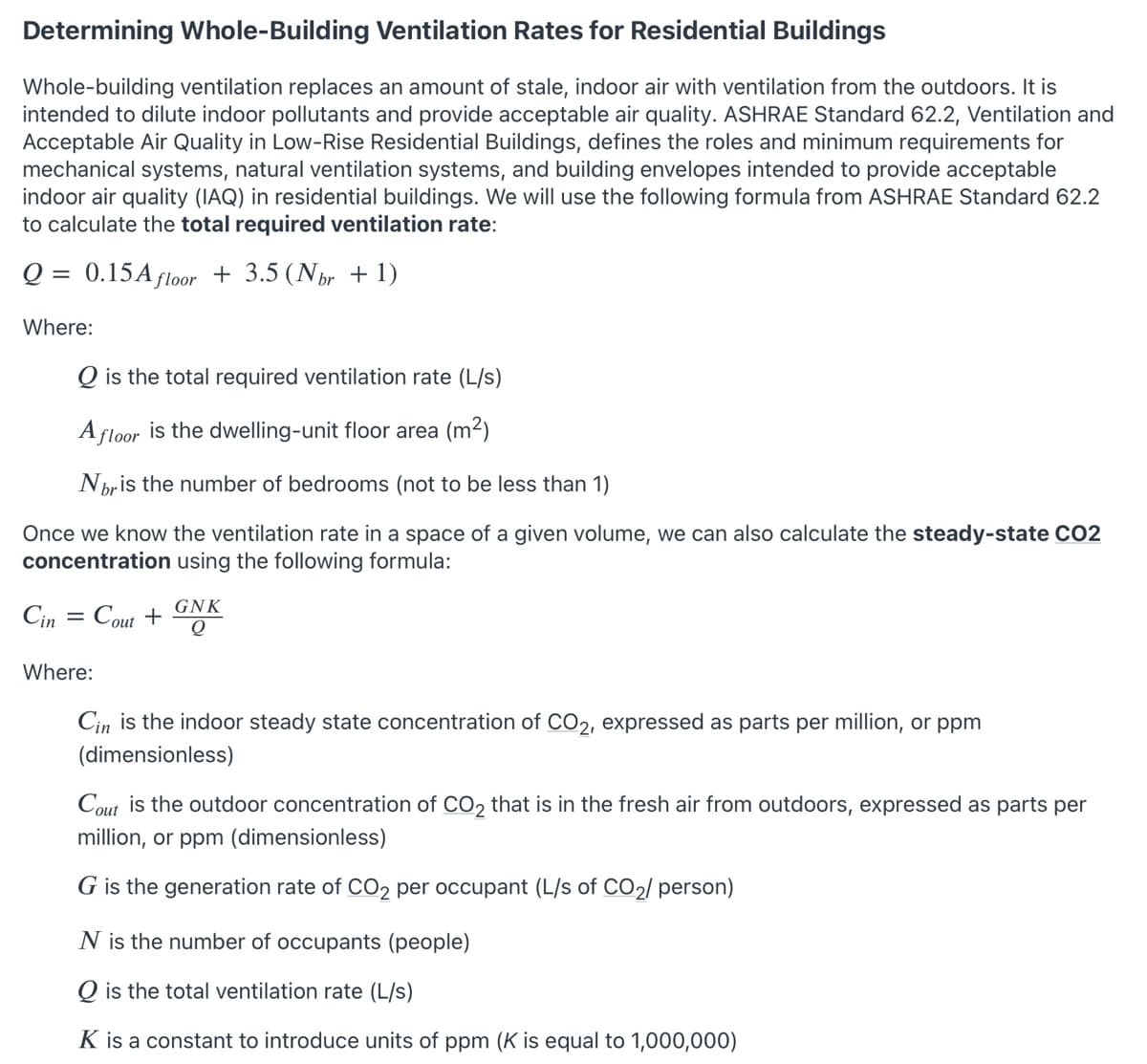Q1: Consider a 3 bedroom, 1,063 square meter single family home to which you would like to add whole-building ventilation. Use the appropriate formula in the image provided to calculate the ASHRAE- recommended whole building continuous ventilation rate. Report your answer in L/s and round the nearest integer.
Q1: Consider a 3 bedroom, 1,063 square meter single family home to which you would like to add whole-building ventilation. Use the appropriate formula in the image provided to calculate the ASHRAE- recommended whole building continuous ventilation rate. Report your answer in L/s and round the nearest integer.
Chapter2: Loads On Structures
Section: Chapter Questions
Problem 1P
Related questions
Question
Q1: Consider a 3 bedroom, 1,063 square meter single family home to which you would like to add whole-building ventilation. Use the appropriate formula in the image provided to calculate the ASHRAE- recommended whole building continuous ventilation rate. Report your answer in L/s and round the nearest integer.

Transcribed Image Text:Determining Whole-Building Ventilation Rates for Residential Buildings
Whole-building ventilation replaces an amount of stale, indoor air with ventilation from the outdoors. It is
intended to dilute indoor pollutants and provide acceptable air quality. ASHRAE Standard 62.2, Ventilation and
Acceptable Air Quality in Low-Rise Residential Buildings, defines the roles and minimum requirements for
mechanical systems, natural ventilation systems, and building envelopes intended to provide acceptable
indoor air quality (IAQ) in residential buildings. We will use the following formula from ASHRAE Standard 62.2
to calculate the total required ventilation rate:
Q = 0.15A floor + 3.5 (Nhr + 1)
Where:
Q is the total required ventilation rate (L/s)
A floor is the dwelling-unit floor area (m2)
Nbris the number of bedrooms (not to be less than 1)
Once we know the ventilation rate in a space of a given volume, we can also calculate the steady-state CO2
concentration using the following formula:
GNK
Cin
Cout +
Q
Where:
Cin is the indoor steady state concentration of CO2, expressed as parts per million, or ppm
(dimensionless)
Cout is the outdoor concentration of CO2 that is in the fresh air from outdoors, expressed as parts per
million, or ppm (dimensionless)
G is the generation rate of CO2 per occupant (L/s of CO2/ person)
N is the number of occupants (people)
O is the total ventilation rate (L/s)
K is a constant to introduce units of ppm (K is equal to 1,000,000)
Expert Solution
This question has been solved!
Explore an expertly crafted, step-by-step solution for a thorough understanding of key concepts.
Step by step
Solved in 2 steps

Knowledge Booster
Learn more about
Need a deep-dive on the concept behind this application? Look no further. Learn more about this topic, civil-engineering and related others by exploring similar questions and additional content below.Recommended textbooks for you


Structural Analysis (10th Edition)
Civil Engineering
ISBN:
9780134610672
Author:
Russell C. Hibbeler
Publisher:
PEARSON

Principles of Foundation Engineering (MindTap Cou…
Civil Engineering
ISBN:
9781337705028
Author:
Braja M. Das, Nagaratnam Sivakugan
Publisher:
Cengage Learning


Structural Analysis (10th Edition)
Civil Engineering
ISBN:
9780134610672
Author:
Russell C. Hibbeler
Publisher:
PEARSON

Principles of Foundation Engineering (MindTap Cou…
Civil Engineering
ISBN:
9781337705028
Author:
Braja M. Das, Nagaratnam Sivakugan
Publisher:
Cengage Learning

Fundamentals of Structural Analysis
Civil Engineering
ISBN:
9780073398006
Author:
Kenneth M. Leet Emeritus, Chia-Ming Uang, Joel Lanning
Publisher:
McGraw-Hill Education


Traffic and Highway Engineering
Civil Engineering
ISBN:
9781305156241
Author:
Garber, Nicholas J.
Publisher:
Cengage Learning